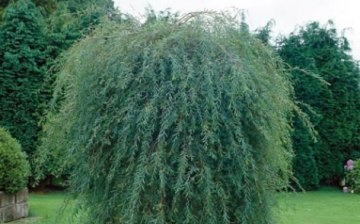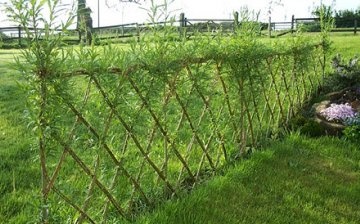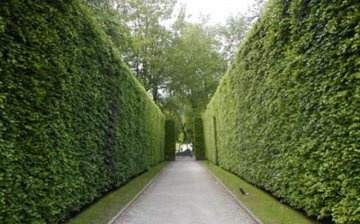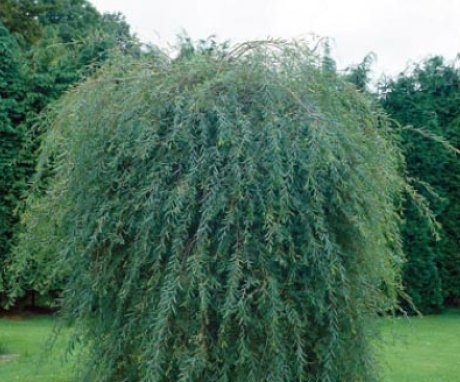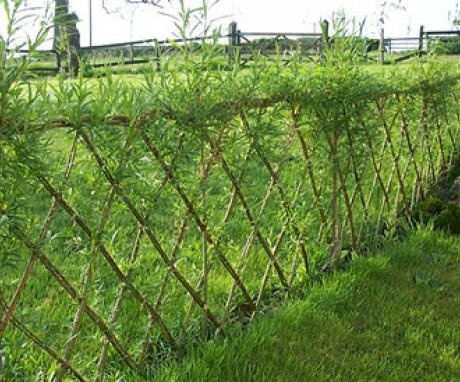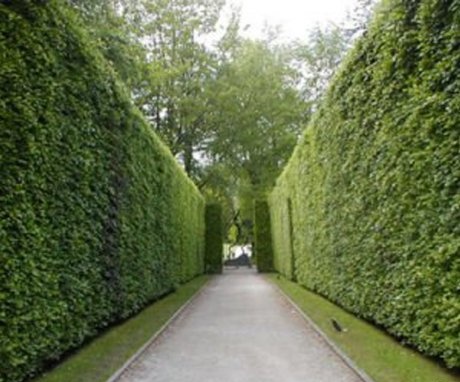Willow hedge: features of formation and care
Landscape designers widely use the construction of hedges. They are both fences and beautiful garden decorations.
Content:
- What types of willow can be used to make a hedge
- DIY hedge construction
- Benefits of willow for hedges
- The most popular hedge plants
What types of willow can you make a hedge
Willows can be found in different regions of the country in different places, they grow along roads, along parks and lakes. When growing them, there will be no problems. Almost all types of willows are suitable for the manufacture of hedges; there are more than 100 of them in nature. More than 350 varieties of willow can also be purchased. The owner of the site has options for choosing what color the leaves of the hedge will be, what shape and volume the crown will be, what the height of the structure will be.
In addition, you can choose the most suitable type of willow for the given climatic conditions, soil, etc. After all, some willows prefer to grow on moist soils, and some cannot exist without arid soil.
Willow hedges are made from the following types:
- The dwarf net willow grows only 30 cm and can be used to decorate garden paths and low fences.
- Matsudana came to us from China. It can be distinguished by its wriggling shoots. Matsudana cannot be grown everywhere as it dies in cold conditions.
- The basket willow can grow up to 8 meters high. The main thing is to plant it in suitable conditions, after which it does not require special care, except for the formation of a hedge.
- Woolly willow is also called shaggy. The plant is small, about 1 meter in diameter. Woolly willow is planted on dry soils, in which there is no stagnation of moisture. The tree tolerates hot summers and cold winters well.
- Rosemary willow is a shrub species that grows up to 2 meters in height. A distinctive feature is the shoots of a red-brown saturated shade.
- The willow is an unpretentious plant, with its help you can plant individual trees and thickets. The height of each individual reaches 8 meters.
- White willow prefers moist soils. This species can be found on the streets of the city, the height of the trunk reaches 30 meters. The willow branches are thin, flexible, falling from the top of the tree, the leaves are long and sharp.
- Purple willow grows no more than 3 meters, the life span of the tree is from 30 years. The species is popular due to the bluish tinge of the leaves and honey-bearing flowers.
- You can grow a three-stalked or five-stalked willow, rod-shaped or dewy. You can often see hedges made of black willow or white thawed willow. In the Far East and Siberia, the species of Siberian willow develops well.
These are not all types of willows that can be used to make a hedge. Before making your choice, you can seek advice from designers and experienced gardeners.
DIY hedge design
To form a hedge, not adults are taken from willow, but cuttings, from which the fence will be formed in the future. You can prepare cuttings yourself by cutting off the shoots of the desired type of willow, or you can buy ready-made ones in a garden store.For cutting cuttings, shoots are taken not from this year, but 2-3 years ago.
Young shoots are not yet lignified, so they may not take root and take root badly in the soil. Older cuttings form healthy shrubs without problems.
Material procurement is carried out in spring or autumn. Autumn shoots are stored in the basement or under the snow.
It is much easier to get cuttings from a store or market. They will already have a developed root system. Pay attention to the fact that the roots are "alive" and not damaged.
The formation of a hedge is carried out in several stages:
- Soil preparation
- Frame formation
- Planting material
- Tying seedlings to the frame
A hole 50 cm deep is dug in the desired place. The depth can vary up or down, depending on the type of willow. When the exact location of the fence is outlined, wooden stakes are driven along its line. The distance between each will be from 1 to 2 meters. Poles are stretched between the wooden supports, on which the seedlings will be tied in the future. The poles can be pulled to simulate a simple pattern.
Now the material is planted along the frame. 1 seedling is placed in one hole. If you need to plant several shoots in a pit, then adhere to a distance of 20 cm between them. After that, the shoots can be tied to the frame. For this, a soft elastic material is used so as not to damage the fragile plant. You can use a cloth, washcloth, or young willow shoots.
Willow is an unpretentious plant, so you can plant seedlings in any month of the summer season.
If the cuttings do not take root in advance, and planting is planned immediately in which soil, then such work is carried out in the spring. As for caring for willow, it is simple. Rather, it concerns the maintenance of the decorative appearance of the site than the vital activity of the willow. With the appearance of weeds, they need to be weeded; in the fall, fallen leaves are collected and burned.
Willow will also react positively to watering in the dry season. In the fall, a superphosphate-based fertilizer can be applied under the roots. If the variety is not resistant to frost, then for the winter the plants are covered with burlap.
In order for the cuttings to grow together more quickly, the bark is trimmed at the point where they touch each other. These places are fixed to each other with a rope, fixation will be required until the shoots finally grow together. In the future, the cuttings can be intertwined, the hedge will be stronger from this. The job of designing a hedge is so easy that even a beginner can handle it.
Benefits of willow for hedges
Hedges are made from different plants. But why is it worth giving preference to willow? It has already been mentioned that willow does not require special care, but these are not all of its benefits.
- The willow does not change its appearance all year round, even in winter, when there is no dense crown left, the tree looks attractive. Outside the warm season, willow branches continue to provide one of their main functions: to fence the site and protect from prying eyes.
- The willow grows rapidly. Two years later, young cuttings form a dense high wall. When the plant becomes an adult, it will be possible to cut new cuttings from it and build new hedges or donate seedlings to friends and acquaintances.
- The high variety of varieties allows you to make the hedge unique, which will suit any landscape. Willow can be tall and short, dwarf or creeping. You can choose the size of the tree, the color and shape of the leaves. A hedge can be made in one row or in two.
Not all trees and shrubs propagate as easily by cuttings as willow. You can also use layering, rooting is quick. Immediately after planting a plant in open ground, it may be weak, do not be afraid, very soon the willow will adapt and begin to grow actively.
Another advantage of willow is the easy planting of seedlings.
There is no need to prepare the pit in a special way, lay drainage and fertilizer. It is enough just to immerse the plant in moist, loose soil 25 cm.
A dense hedge, even without leaves, can protect the site from wind and dust. Such a fence will last at least 20 years, some species live for 50 years, so the structure can be called durable.
Shoots can often be pruned for your own purposes. Willow quickly resumes them. But the soil on the site of the hedge will become more fertile. The willow root system has a high level of activity, in addition, the soil is saturated with trace elements from falling leaves. After building a willow hedge, there is hardly any disappointment or desire to replace it with another plant.
The most popular hedge plants
To fencing the site or dividing it into zones, hedges are used. They can be made from trees, shrubs and even perennial herbaceous plants.
Tall hedges can be made from the following plants:
Each of the above plants has many species. Preference should be given to species whose height is no more than 4 meters, then it will look more accurate. These trees will need to be pruned periodically to form a crown.
If there is no time and desire to engage in the molding of branches, then you can make an unformed hedge. Then the distance between the trees is from 0.5 to 1 meter. The following trees are used: chubushnik, irga, viburnum, honeysuckle, apple tree, lilac.
A more expensive but sophisticated hedge will be made from conifers. The most popular plants: spruce, cypress, juniper, yew, thuja.
Considering a hedge according to the criterion of tall plants, it is worth listing medium-sized trees. Their height is no more than 2 meters, usually these trees are easy to form and tolerate pruning well. Use: acacia, currants, vesicle, maple, dogwood, barberry, hawthorn.
For uncut hedges, the following are used: spruce, thuja, spirea, cypress, chubushnik, currant, dogwood, barberry, cotoneaster. Gardeners recommend planting not only conifers on the site, but diluting them with deciduous ones. This will not only make the composition easier, but also make it more lively, which will change its appearance with the change of the season.
You can also make a low hedge. Most often it is used to decorate the site and to design a green rest room, a kind of gazebo. Such hedges do not exceed a height of 1 meter. You can choose plants that need crown formation, or you can choose non-molded species.
The most popular plants for molded hedges are:
For unformed:
- Cypress
- Rosehip
- Snowberry
- rose flower
- Spirea
You can decorate your garden with flowering plants: roses, rose hips, honeysuckle, hydrangeas, spirea, lilacs, etc. Each plant is unique and beautiful in its own way. A hedge of trees and shrubs will serve as both a fence and a decorative filling of the site. A hedge made of willow or other trees does not require much maintenance. In turn, they will not leave indifferent the owners and guests of the garden.
More information can be found in the video.




